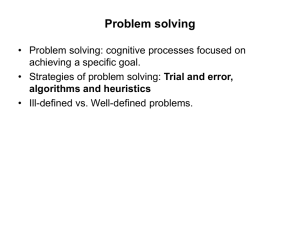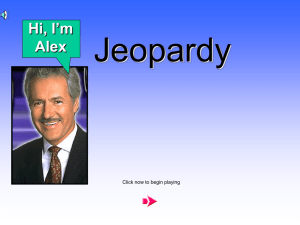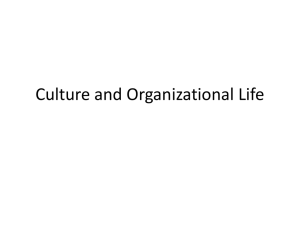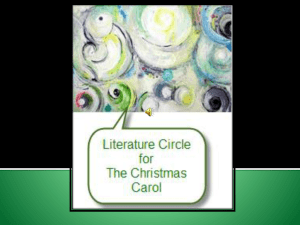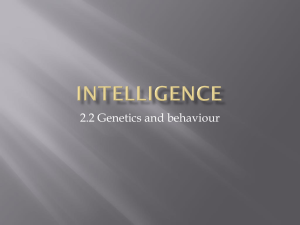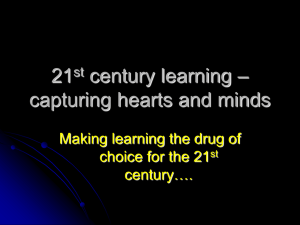Individual Differences In Intelligence
advertisement
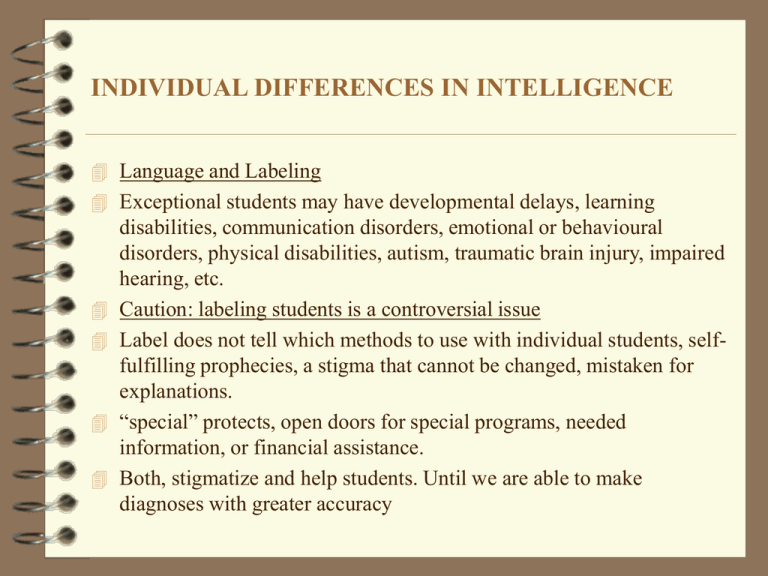
INDIVIDUAL DIFFERENCES IN INTELLIGENCE Language and Labeling Exceptional students may have developmental delays, learning disabilities, communication disorders, emotional or behavioural disorders, physical disabilities, autism, traumatic brain injury, impaired hearing, etc. Caution: labeling students is a controversial issue Label does not tell which methods to use with individual students, selffulfilling prophecies, a stigma that cannot be changed, mistaken for explanations. “special” protects, open doors for special programs, needed information, or financial assistance. Both, stigmatize and help students. Until we are able to make diagnoses with greater accuracy WHAT DOES INTELLIGENCE MEAN? 1. The capacity to learn; 2. The total knowledge a person has acquired; and 3. The ability to adapt successfully to new situations and to the environment in general. Most agreed: abstract reasoning, problem solving, and decision making . Disagreed about the structure of intelligence. INTELLIGENCE: ONE ABILITY OR MANY? Some believe intelligence is a basic ability that affects performance on all cognitive oriented tasks. Charles Spearman suggests there is one factor or mental attribute, g general intelligence, that is used to perform any mental test, but that test also requires some specific abilities in addition to g. Spearman assumed that individuals vary in both general intelligence and specific abilities, and that together these factors determine performance on mental tasks. MULTIPLE INTELLIGENCES GUILFORD suggests three basic categories, or faces of intellect: mental operations, or the processes of thinking; contents, or what we think about; and products, or the end results of our thinking. 1. Mental operations are divided into six subcategories: cognition, convergent thinking, divergent thinking, evaluation, immediate memory,and memory overtime 2. The contents on which people operate are divided into five subcategories:visual content, auditory content, word meanings, symbols, and behaviours. 3. The different Products that may result are units, classes, relations, systems, transformation, and implications. HOWARD GARDNER: MULTIPLE INTELLIGENCES THREE separate kinds of intelligence: linguistic (verbal), musical, spatial, logicalmathematical, bodily kinesthetic, understanding of others (interpersonal), and understanding of self (intrapersonal). Individuals often excel in one of these areas but have no remarkable abilities in the other six. There may be more kinds of intelligence - seven is not a magic number. ROBERT STERNBERG’S TRIARCHIC THEORY OF INTELLIGENCE ANALYTIC, CREATIVE, AND PRACTICAL. 1. Analytic intelligence involves a. Metacomponents Higher- mental processes of the individual that leads to more or less intelligent behaviour Components - elementary information processes that are classified by the functions they serve and how general they are. At least three functions they serve. order planning, strategy selection, and monitoring is performed by this. b. Performance components executing the strategies selected. c. Knowledge-acquisition components gaining new knowledge, such as separating relevant from relevant information as you try to understand a new concept CREATIVITY The second part of Sternberg’s Triarchic theory Involves coping with new experiences. Intelligent behaviour is marked by two characteristics: 1. Insight, or the ability to deal effectively with novel situations, and 2. Automaticity - or the ability to become efficient and automatic in thinking and problem solving. Involves solving new problems that can be applied without much cognitive effort. PRATICAL INTELLIGENCE The third part of Sternberg’s Triarchic Theory Highlights the importance of choosing an environment in which a person can succeed, adapting to that environment, and reshaping it if necessary. Abilities that make a person successful in a rural farm community may be useless in the inner city. Intelligence in this sense involves practical matters such as career choice or social skills. HOW IS INTELLIGENCE MEAUSRED? Intelligence, as measured by standard tests, is related to learning in school? Why is this so? It has to do in part with the way intelligence tests were first developed. INTELLIGENCE QUOTIENT (IQ) Alfred Binet Mental age. In intelligence testing, a score based on average abilities for that age group. A child who succeeded on the items passed by most six-year-olds, for example, was considered to have a mental age of six. The concept of IQ was added after Binet’s test was brought to the US and revised at Stanford University Stanford-Binet test. IQ= mental age X 100 Chronological age Deviation IQ is a number that tells exactly how much above or below average a person scored on the test, compared to others in the same age group. GROUP versus INDIVIDUAL TESTS Stanford-Binet is an individual intelligence test. Group test can be given to whole classes or schools. Group test is much less likely to yield an accurate picture of any person’s abilities As a teacher, you should be very wary of IQ scores based on group tests. WHAT DOES AN IQ SCORE MEAN? Intelligence and achievement Intelligence test scores predict achievement in schools quite well, at least for large groups. But do people who score high on IQ tests achieve more in life? Here the answer is less clear. Factors like motivation, social skills, and luck may make a difference. INTELLIGENCE Nature - versus - nurture Most believe that differences in intelligence are due to both heredity and environment, probably in about equal proportions for children. “Genes do not fix behaviour. Rather they establish a range of possible reactions to the range of possible experiences that the environment can provide” And environmental influences include everything from the health of a child’s mother during pregnancy to the amount of lead in the child’s home to the quality of teaching the child receives. Cognitive skills, like any other skills, are always improvable. Intelligence is a current state of affairs, affected by past experiences and open to future changes. Even if I. Is a limited potential, the potential is still quite large, and a challenge to all teachers. ABILITY DIFFERENCES AND TEACHING Between-Class A. Grouping and Within-Class A. Grouping Between-Class A. G or tracking. when whole class are formed based on ability . Segregation by ability may benefit high-ability students slightly, but it often causes problems for low-ability students. L.a. classes seem to receive lower-quality instruction. Student self-esteem suffers. Can have a long-term implications Within-class A.G..Clustering students by ability within the same class. Many elementary-school classes are grouped for reading, and some are grouped for math. If you use Homogeneous small groups in your class the guidelines should make the approach more effective. DEVELOPMENTAL DISABILITIES Students with moderate to severe developmental delays have significant limitations in cognitive abilities and adaptive behaviours Learn at a far slower rate. Have difficulties maintaining skills without ongoing practice, and generalizing skills learned in one context to another. Difficulties carrying out tasks that involve combining or integrating multiple skills DEVELOPMENTAL DISABILITIES (cont.) IQ below 70 to 75 is one indicator of a developmental delay, but it is not enough evidence to diagnose a child as having a developmental disability There must also be problems with adaptive behaviour, dayto-day and social functioning. Caution: when interpreting the scores of children from different cultures Two principles to which to base instruction for students with D.D.: a functional curriculum and a community-based education A functional curriculum means setting goals and targeting skills that will help students succeed in life outside of school. Relating what is learned in school to community contexts. Read guidelines for teaching. GIFTED AND TALENTED No agreement about what constitutes as gifted student. Can have many different gifts. Guilford claims there are 180. Renzulli and Reis (91): giftedness as a combination of three characteristics: aboveaverage general ability, a high level of creativity, and a level of task commitment or motivation achieve certain areas WHAT PROBLEMS DO THE GIFTED FACED? Boredom and frustration in Recognizing students’ special school as well as social isolation 9sometimes even ridicule) from peers. Focused on issues or totally absorbed in computers, drama, or geology. Difficult to accept their own emotions, because the mismatch between mind and emotion can be great. May be impatient with friends, parents, and even teachers who do not share their interests or abilities. abilities. How do you separate gifted students from hardworking or parentally pressured students? Some very able students deliberately earn lower grades, making their abilities even harder to recognize. Seven questions are good guides to pick out gifted children in your class TEACHING GIFTED CHILDREN Teaching methods for gifted children should encourage abstract thinking (formaloperational thought), creativity, and independence, not just the learning of greater quantity of facts. Teachers must be imaginative, flexible, and unthreatened by the capabilities of these students What does this child need most? What is she or he ready to learn? Who can help me to challenge them? CREATIVITY CREATIVITY AND COGNITITON Gardner defines “a person To be creative, the “invention” who regularly solves problems, fashions products, or defines new questions in a domain in a way that is initially considered novel but that ultimately becomes accepted in a particular setting” This conception suggests that there is no such thing as “all purpose creativity”; people are creative in a particular area must be intended. Creativity and Cognition having a rich store of knowledge in an area is the basis for creativity, but something more is needed. The ability to break set restructuring the problem to see thing in a new way, which leads to a sudden insights. ASSESSING CREATIVITY Requires extensive knowledge, flexibility, and the continual reorganizing of ideas Motivation and persistence play important roles in the creative process. Equate creativity with divergent thinking . Divergent thinking is the ability to propose many different ideas or answers Foster and encourage creativity can try brainstorming. Separate the process of creating ideas from the process of evaluating them because evaluation often inhibits creativity. LEARNING STYLES Individuals differ in how they approach a task, variations have to do with “characteristic modes of perceiving, remembering, thinking, problem solving, and decision making, reflective of information-processing regularities that develop … around underlying personality trends. Field dependent people tend to perceive a pattern as a whole, not separating one element from the total visual field. Difficulty focusing on one aspect of a situation, picking out important details, analyzing a pattern into different parts or monitoring their use of strategies to solve problems FIELD-DEPENDENCE & FIELD-INDEPENDENCE F-D.work well in groups, have Not attuned to social a good memory for social formation, and prefer subjects such as literature and history Field-independent people monitor their own information processing, perceive separate parts of a total patterns and able to analyze a pattern according to its components. relationships, do well in math and science where their analytical abilities pay off. Should be aware that students approach problems in different ways. Some may need help learning to pick out important features and to ignore irrelevant details. They may seem lost in less structured situations and need clear, step-by-step instructions. IMPULSIVE & REFLECTIVE COGNITIVE STYLES Impulsive students work very quickly but make many mistakes. Reflective students work slowly and make few errors As with F-Dep/F-Indep., imp/ref. Cognitive styles are not related to intelligence within the normal range. Students can learn to be reflective, if they are taught specific strategies Learning styles and preferences. Learning styles are approached to learning and studying: Deep and surface approaches to processing information in learning situations. DEEP PROCESSING & SURFACE PROCESSING LEARNING PREFERENCES Deep-processing App. To Surface-processing App. Focus learning see the learning materials or activities as a means for understanding some underlying concepts or meanings. Less concern about how their performance is evaluated, motivation plays a role. on memorizing the learning material. Motivated by rewards, grades, external standards, and the desire to be evaluated positively by others. LEARNING PREFERENCES Preferences for particular learning environemnts
